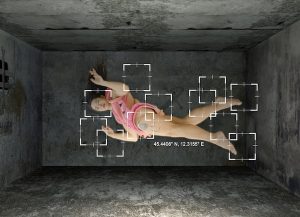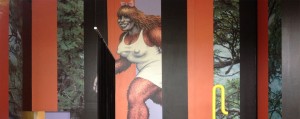In many ways, Anthea Hamilton’s Let’s Go at Bloomberg Space, is a continuation of the mixed media artist’s recent work at Tate Modern’s The Tanks live venue. Performances of classical Japanese dance theatre, based around the dances of Noh and Kabuki, are acted out, in tandem with the four phases of the moon, against a backdrop of wallpaper featuring Robert Crumb’s American Folk comic art. Bright yellow piping and kimono sculptures hyperlink one culture to another, across disparate narratives from past generations to the present.
With men playing women, novices take on Kabuki’s bizarre costumes and make-up, or Noh’s rigorous day-long plays. Performed by Jordan John-Hope and Gervais Cedric Bitijoka, the setup faces out onto Finsbury Square, clashing not only traditional choreography, in the form of gestures and footwork, but also the reflective bright-yellow lines and some of the underlying xenophobia that Crumb’s densely cross-hatched depictions of African-American women represent.
Key to this is juxtaposition. Movement, scale, materiality and narrative come together, all at once. Before, Hamilton used ultra-thin cutouts of figures like John Travolta or Karl Lagerfeld to tempt us into exploring the worlds of movie stardom or fashion hedonism head on. Now, the RCA graduate’s theatrical props envelope the viewer into the scenery with orchestrated precision. A photograph of the forest monumentally covers the walls up to the high ceiling, striped over with bold orange and black blocks of colour, only to be broken up by a snide, beefy-hairy Crumb cartoon character, casually crossing between both scenes.

All of this is Hamilton’s attempt to get closer to a situation where work can be touched and interacted with. Differences in form and scale are meant to disorient a visitor; tension binds them to the place, while breaks in the installation keep a conventional way of viewing objects out of sight. Vistas in the space control views. Dramatic entrances keep the viewer unsettled. Even the sound of your shoes hitting the black tiled ground is a conscious effort to make ideas click.
Previously, Hamilton immersed herself in video, literally playing onscreen personas, in what was a form of self-portraiture. Though they never made it into her final portfolio, they mark some of the thinking behind her move to three-dimensional objects. Here, it’s possible to go beyond the limit of appropriating existing film clips spliced with home movies, to situations where a spectator can be involved and self-initiated action can take place, while still connecting with Hamilton’s personal narrative through physical images in a performance space.
An essential evolution in Hamilton’s work, absent from this display, is the Chroma-key backdrop. The blue paint, usually to be found on video TV productions like the weather report, creates neutral spaces, blanker than a white cube, giving an aura of a film set (especially with a few celebrity cut-outs for company). But in Let’s Go, the photographic wallpaper of a rural backdrop stands in their place, clearly setting the scene into which the viewer is invited. And if much of the narrative doesn’t immediately make sense, it’s simply because Hamilton makes no excuses for a work that’s a personal exploration of its own art-historical references. Let’s Go feels raw, unfinished and with that comes a real energy, a feeding of contemporary art’s constant flux between diverging cultures.
Anthea Hamilton Let’s Go runs at Bloomberg Space July 26 to September 14, 2013.
share news item

